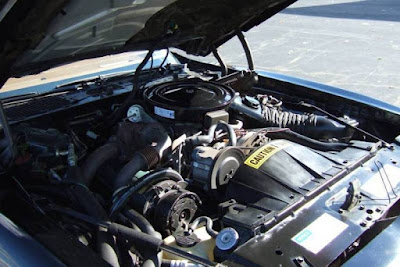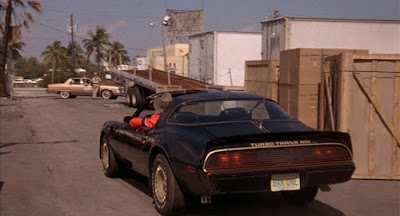Keep in mind that General Motor's myriad divisions were still fairly autonomous as recently as the late 1970's. Therefore it's fairly safe to assume then that the idea of Pontiac using a Chevrolet V-8 engine in the image-conscious Trans Am was verboten. Chevrolet could have said no too for all it matters. Anyway, the reality was whether the hamstringing was self-inflicted or not, Pontiac's engineers went back to the lab to do what was deemed virtually impossible at the time - bake up a high performance, fuel-efficient engine that could pass ever more stringent federal fresh air regulations.
What they come up with was the "Turbo 4.9". Using an AiResearch turbocharger on top of a beefed up version of their 301 cubic inch V-8, Pontiac claimed it made 210 horsepower and 345 pound-feet of torque. Quite impressive considering the Oldsmobile 403 that powered 1979 T/A's made just 185 horsepower and 325 pound-feet of torque. Quite impressive - on paper.
Despite higher horsepower and torque ratings, published year-to-year drag tests indicate a 0-60 time a full second slower and quarter mile time 10 miles per hour lower. Might not sound like much of a drop but to the seat of your pants, those drops were enormous especially in a car that had sporting pretension. There's no way "The Bandit" was too happy with his 1980 Turbo T/A in "Smokey and the Bandit II". If you're wondering, "I" was the one with the beer while "II" was the one with the elephant. Yes. An elephant.
The problem with the "Turbo 4.9" was in the real world it just didn't work very well. The little AirResearch turbo made just 9 pounds of boost and the charge it made was forced through tortuous plumbing upstream into the carburetor. The literal heavy lifting that the engine did, these cars were quite hefty, came primarily from modifications done to the engine above and beyond the turbocharger. To increase airflow, Pontiac used an oversized Quadrajet on a high rise, offset (note the hood bulge) aluminum intake manifold. To make the most of the twist, they used a 3.08 rear axle. Pontiac would probably been better off just hopping up the 4.9 sans the turbo, again if the Corvette or Camaro engine was not available, but selling a car with a new engine that was 102 cubic inches smaller than what it replaced was a long enough putt. "Turbo", implies power and speed even if, in the case of the 1980-1981 Turbo Trans Am, it's little more than a sticker. after At least the Turbo Trans Am got this lovely nose job and oh, those rims. To die for.
Despite higher horsepower and torque ratings, published year-to-year drag tests indicate a 0-60 time a full second slower and quarter mile time 10 miles per hour lower. Might not sound like much of a drop but to the seat of your pants, those drops were enormous especially in a car that had sporting pretension. There's no way "The Bandit" was too happy with his 1980 Turbo T/A in "Smokey and the Bandit II". If you're wondering, "I" was the one with the beer while "II" was the one with the elephant. Yes. An elephant.
The problem with the "Turbo 4.9" was in the real world it just didn't work very well. The little AirResearch turbo made just 9 pounds of boost and the charge it made was forced through tortuous plumbing upstream into the carburetor. The literal heavy lifting that the engine did, these cars were quite hefty, came primarily from modifications done to the engine above and beyond the turbocharger. To increase airflow, Pontiac used an oversized Quadrajet on a high rise, offset (note the hood bulge) aluminum intake manifold. To make the most of the twist, they used a 3.08 rear axle. Pontiac would probably been better off just hopping up the 4.9 sans the turbo, again if the Corvette or Camaro engine was not available, but selling a car with a new engine that was 102 cubic inches smaller than what it replaced was a long enough putt. "Turbo", implies power and speed even if, in the case of the 1980-1981 Turbo Trans Am, it's little more than a sticker. after At least the Turbo Trans Am got this lovely nose job and oh, those rims. To die for.
Notoriously difficult to modify, most Turbo 4.9's were yanked in favor of torquier, more powerful and reliable 400s and 455s. Which makes any remaining running Turbo Trans Ams very rare, ahem, birds. Sorry. Pontiac, wisely, charged only $350 for the turbo option above and beyond "base" Trans Am's and Formula Firebirds, yes, the turbo was available on the Formula Firebird (Turbo Formula), with non turbocharged 301 engines.
About the only thing more disappointing than the performance of the Turbo Trans Am was the dreadful "Smokey and the Bandit II". Panned by critics and a box office dud, Pontiac didn't see anywhere near the sales increase for the T/A they had when "I" burst onto the scene. So, that's the impetus for my wondering if the T/A would have gone on as long as it did without the success of the first "Smokey". Let's not even go there about "Smokey III" - yes, there was one featuring a 1983 "little" T/A where Snowman was Bandit and...oh. Never mind. Not that the "Smokey" trilogy was really about Pontiac, but with Pontiac dead and buried, I wouldn't hold my breath for a fourth installment. That's probably a good thing.







No comments:
Post a Comment